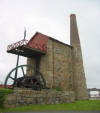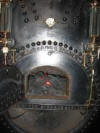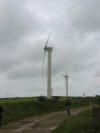

CAUSE 2003 Home Previous Dispatch Dispatch Home Next Dispatch
Newcomen to Brunel - A Path of Progress
Day 7: Penzance to Bath
by Rebecca Klossner
Its Quiz Time
 After
a late night of discussion we were up bright and early for our quiz in the basement
of the Penzance Youth Hostel. Our quiz covered two readings, Assessing Energy
Technologies and Environmental Impacts with the Principles of Thermodynamics
by Marc Rosen and Energy and Equity by Ivan Illich.
After
a late night of discussion we were up bright and early for our quiz in the basement
of the Penzance Youth Hostel. Our quiz covered two readings, Assessing Energy
Technologies and Environmental Impacts with the Principles of Thermodynamics
by Marc Rosen and Energy and Equity by Ivan Illich.
The quiz asked three basic
questions (I will provide you with my answers, I am sure there are many varying
opinions, seeing that the questions are fairly open ended):
Basically, exergy is a “measure of
the potential of a substance or energy form to impact the environment”. It includes
the first and second laws of thermodynamics, the conservation of energy and
the non-conservation of entropy.
Exergy provides a method which includes all inefficiencies, as well as inefficiencies
in energy. Therefore it gives a more comprehensive term to account for everything
which can change equilibrium in a system. This will help to quantitatively include
environmental impacts in policy making.
My group ranked the power plants as such, each group had a different ranking and I am sure logical cases could be made for other rankings as well:
Illich discusses transportation from an energy inefficient stand point. For example, he states that transportation creates a specific path to go from one place to another, which may not always be the best way to get there. As we decrease our energy efficiency, the environmental impact increases exponentially and the sustainability of the system approaches zero. Illich desires a low exergy environment in which we set limits for our speed and stop the perpetual increases in transportation speeds which cause our society to be energy inefficient.
With the quiz behind us, we set off for a day that would give us a glimpse of our past, present and future in terms of the way we harness and manipulate our natural resources to create energy.
Camborne Geothermal Project
Our first stop of the morning was he Camborne Geothermal Project. This “hot dry rock” geothermal project, used for heating and electricity conversion, began in 1985. The goal of this scheme, which was conceived at Los Alamos in the in 1970s, was to deplete heat from the granite below in order to extract thermal energy. The hot dry rock heat mining is a fairly simple concept. Water is pumped down into hot, crystalline rock by an injection well. The water then becomes superheated while flowing through the fractures in the hot rock below, and is returned to the surface through production wells as steam which can be used for either heating or electricity generation.
Geologists believed that the Camborne area was ideal for this type of mining because the particular moor that the site stands on is actually a capola on top of a granite intrusion. The granite can be easily fractured, so that the water can travel between the injection well and the production well becoming heated in the process.
 In this particular scheme,
the two red caps shown in the picture above are the well heads. These wells
go to a depth of approximately two kilometers. Once the first hole, or the injection
well, was drilled it was fracked in order to create a hydraulic fracture zone.
In this particular scheme,
the two red caps shown in the picture above are the well heads. These wells
go to a depth of approximately two kilometers. Once the first hole, or the injection
well, was drilled it was fracked in order to create a hydraulic fracture zone.
Micro-seismic waves were used to locate the fracture events, and the second hole, or the production well, was drilled to meet the fracture in the granite. This creates a heat exchange zone under the earth’s surface (See the schematic below).
Unfortunately, this site never went into production. The population in the Camborne area has never been large enough to support this type of project. Also, the temperature gradient at this site was only 30-33°C / km, which is not hot enough unless a binary system is used to raise the temperature of the hot water into water vapor. Recently there has been a resurgence of interest in this area. In the past, the drilling costs always limited the use of this type of scheme, but costs in this area have declined.
After learning about this site we
were asked to complete two calculations:
1. How much thermal energy is coming out by our feet at this site?
We know: the thermal gradient, dT/dx, is 30°C/km
Thermal conductivity of granite, K, is 2.6 W/(m°C)
We used the heat flux, q, equation: q = K * dT/dx = 780 W/km2
2. Find the area of rock
needed to get 1 GW of power from this site.
We know: the thermal gradient is 30°C/km
the specific heat of granite is 1000 J/(kg°C)
the source will deplete (all ground will be 100°C) after 50 years

We used the following equations
to find the answer to this problem:
Energy = specific heat * m * ? T
m = density * area * depth
The equations were solved for area, the depth is 7 km, the ? T is 105°C
in 50 years, and the specific gravity of granite is 2.75 g/cm3.
1,000,000,000 J/s = 1000 J/kg°C * 2.75 g/cm3 * 1 kg/1000g * 100,000cm/1km
* area * 7km * 105°C/50yr * 1yr/360days * 1day/24hours * 1hr/3600s
In this case (please check my math) the area needed is 0.769 km2
Cornish Mines and Engines
Cornish boys are miners,
Cornish boys are fishermen too,
When all the mines and fish are gone,
What will Cornish boys do.
Graffiti on the wall of the closed South Crofty Mine in Redruth
 As
we left the geothermal site which was developed less than twenty years ago,
we traveled to the site which took us much farther into the past, the East Pool
Whim. A whim is basically a winding device used for hauling men and ore up from
a mine shaft. The whim we visited serviced the East Pool Mine, which lies in
the heart of the great central mining district of Camborne-Redruth. The mine
is located 1500 feet below the surface of the Earth and the whim brought ore
and men to the surface at 500 feet per minute. This steam winding engine of
the beam type was the last of its kind to be created in 1887. It was designed
by a local engineer, E.W. Michell and was constructed by Holman Bros.
As
we left the geothermal site which was developed less than twenty years ago,
we traveled to the site which took us much farther into the past, the East Pool
Whim. A whim is basically a winding device used for hauling men and ore up from
a mine shaft. The whim we visited serviced the East Pool Mine, which lies in
the heart of the great central mining district of Camborne-Redruth. The mine
is located 1500 feet below the surface of the Earth and the whim brought ore
and men to the surface at 500 feet per minute. This steam winding engine of
the beam type was the last of its kind to be created in 1887. It was designed
by a local engineer, E.W. Michell and was constructed by Holman Bros.
Steam acts alternately on the top and bottom sides of the piston and is then
exhausted to a condenser instead of being discharged into the atmosphere. This
type of double-acting engine was very economical because it could do a day’s
hoisting using a relatively small amount of coal. The engine’s efficiency was
also increased because the inner cylinder was kept hot by steam at full boiler
pressure. The schematic below shows an extremely simplified view of how the
steam was actually created:
The boiler design was created by a Cornish man named Richard
Trevithick. The boiler design was more efficient because the fire was actually
put inside of the boiler. It was also a stronger design because there were fewer
corners so the boiler could withstand higher pressures. The original boiler
was demolished when the mine was closed in 1921. It was rebuilt by the National
Trust in 1975. Engineering feats such as these drove the industrial revolution
in England, but the need for Welsh coal was a prime concern during most of Cornish
mining history.
Although we did not get a chance to observe the large beam engine used to pump water from the mine, it should be noted that the engine is very unique. It is located at Taylor’s Shaft, and is both the largest and the youngest surviving Beam Engine in Cornwall. The engine weighs over 125 tons with a 90 inch diameter cylinder, it moved 27,000 gallons of water an hour for just under thirty years.
Wind Farms
 We left the industrial revolution site and headed for
something a great deal more modern. As we drove around the Cornish country side
the windmills were hard to miss. They greatly change the entire landscape, as
well as reflect a move to more “environmentally friendly” methods of generating
energy. Many wind farms have recently been erected in the southwest of England.
We left the industrial revolution site and headed for
something a great deal more modern. As we drove around the Cornish country side
the windmills were hard to miss. They greatly change the entire landscape, as
well as reflect a move to more “environmentally friendly” methods of generating
energy. Many wind farms have recently been erected in the southwest of England.
The first site we visited was located in the middle of a muddy daffodil field,
which did cause some problems with the vans! In general, people are concerned
about the noise that will come from the rotor blades, the visual impacts, and
the killing of birds. When we got out to have a look we were impressed by the
monstrous size of the windmills, and the fact that there were no dead birds
around the area. Another complaint was that these turbines would be too noisy,
but when we stepped out I was surprise to find that the sound created was of
the same caliber as water flowing down a small stream.
 The next stop was Carland Cross, a six megawatt wind farm
with fifteen turbines. The blades were rotating at about 40 revolutions a minute,
slightly faster than the pervious farm. After piling back into the vans we discussed
the United Kingdom’s goal to have 10% of their energy needs met by renewable
by 2010. Currently only 3% of the energy is from renewable resources and only
one tenth of that is from wind.
The next stop was Carland Cross, a six megawatt wind farm
with fifteen turbines. The blades were rotating at about 40 revolutions a minute,
slightly faster than the pervious farm. After piling back into the vans we discussed
the United Kingdom’s goal to have 10% of their energy needs met by renewable
by 2010. Currently only 3% of the energy is from renewable resources and only
one tenth of that is from wind.
Wind Farms in the
UK
At a glance ....
Projects Turbines Megawatts Homes Equivalent CO2 reductions SO2 reductions NOX
reductions
82 1030 587.6 386,000 1,330,000 tones 15,400 t 4630 t
Source: The British Wind Energy Association Website
The British government hoped to install another 300 megawatts of wind capacity
in 2003. Their projects include a 30 turbine, 60 MW farm located in Clwyd and
a 39 turbines, 58.5 MW farm located in Ceredigion. The total confirmed new capacity
for 2003 is now 321.575 MW, exceeding the goal.
Steam Tractor
As we headed toward Bath, we took a short pit stop to see a steam tractor drive by on the highway. The tractor seemed to crawl past us as cars sped by so we got a good glimpse. It appeared to be used for agriculture and was powered by diesel fuel. It was another reminder of how drastically things have changed in the past century.
Severn Barrage
From the flurry of new wind
farms constructed every year, it is obvious that the UK is serious about renewable
energy. As wind moves into the spot light as an economical renewable, other
forms of renewable energy are sure to follow. Currently the UK does not have
any operating tidal schemes used for creating electricity, despite the fact
that this type of electricity generation has been successful in France since
1966. Tidal power sites identified in the UK could provide as much as a fifth
of the electricity requirements. Over 90% of this electricity would come from
only eight large schemes.

England is full of estuaries,
or places where rivers meet the sea. These areas are particularly interesting
because the differences between high and low tides are drastically increased
as the water is funneled up the estuary. The Severn Estuary has one of the largest
tidal ranges in the world. The difference between high and low tides is over
11 meters in the vicinity of the Severn Bridge! (The Severn Bridge is shown
in the picture) The proposed tidal barrage would stretch nearly 10 miles between
Brean Down in Somerset and Lavernock Point in Glamorgan, creating a tidal basin
of more then 500 square kilometers. The proposal includes 216 turbines each
driving a 40MW generator, creating an 8,640 MW scheme.
These type of schemes work by trapping the water at high tide. As the sea level
outside falls naturally, the gates are opened, and as the water rushes out it
is used to turn turbines to generate electricity.
One of the main drawbacks to this proposal is the considerable cost and time
needed to create such a large structure. The Severn barrage estimates are around
£11 billion or $17,346,062,228.81 and a nine year period to build the
structure. As always the environment is a main concern and the effects of these
schemes are difficult to predict. As we pass over the River Severn in our large
vans its hard to imagine what might become of this unique estuary.
Onward to Bath
We traveled onward towards Bath where we would be staying the night. The trip
definitely gave me some time to reflect on the extensive range of sites we saw
in one day. We saw a large winding engine and a steam powered tractor where
the technology has become out of date, and is no longer used today in our society.
We saw a hot dry rock project that never really took off. I guess in order to
move forward in our search for alternative forms of energy we will have projects
that don’t work out the way we desire. We saw wind farms, a technology which
is just starting to advance throughout the UK. Finally we drove over the River
Severn. Although there was no structure in place to look at, one could imagine
a large structure spanning the estuary to harness some of the largest tidal
ranges in the world. In all, the day illustrated the constant demand for energy
throughout the last century, and the ever changing role of what supplies the
energy necessary to our society.
Sources
Pictures: Jonathan Matthews
Severn Barrage: http://www.energy.org.uk/EFTidal.htm
Cornish Engines: Cornish Engines Pamphlet, 1987 The National Trust
Camborne Geothermal: Derek Elsworth, http://www.ees4.lanl.gov/hdr/
Wind: The British Wind Energy Association Website, www.bwea.com
Rebecca Klossner is a Senior in Materials Science & Engineering.
CAUSE 2003 Home Previous Dispatch Dispatch Home Next Dispatch
Last updated: Wednesday December 03, 2003